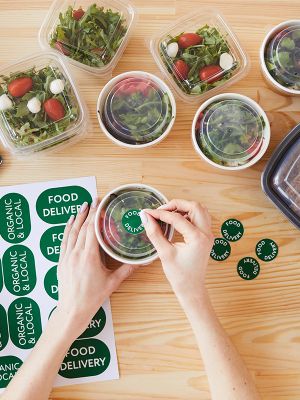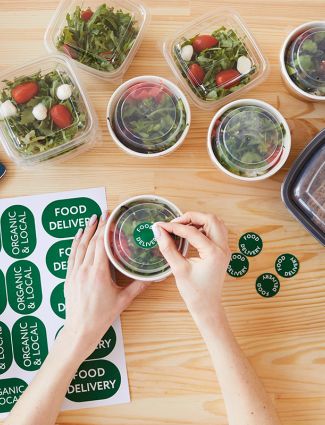
Food For Thought: How AI Powers Food Delivery for Better Gastronomic Experiences

Food For Thought: How AI Powers Food Delivery for Better Gastronomic Experiences
Craving for Better CX in Online Food Delivery Services? Have a Bite of AI
In 2020, the global online food delivery services market grew to $115 billion1 and is expected to hit $192 billion in 2025 with a compound growth rate (CAGR) of 11%. While restrictions are easing and in-dining experiences are on the rise, customers remain heavily reliant on technology and will most likely continue online or in-app ordering2 as long as they’re provided with exclusive perks. How then should the online food ordering industry sustain its momentum?
In this article, TaskUs sinks its teeth into the current state and capabilities of using technology, particularly artificial intelligence, in food delivery. More so, we introduce our menu of artificial intelligence and machine learning capabilities to help some of the world’s most disruptive food delivery companies serve their hungry customers and drive customer satisfaction.
The Table is Set: Artificial Intelligence in the Food Delivery Landscape
Technology has changed the way we eat. Ordering food has become fast and easy thanks to digitization.
- According to a report by Toast3, 73% of diners say that restaurant technology improves their guest experience, and 95% of restaurateurs agree that it boosts their business efficiency.
- Online food ordering is growing at an exponential pace, 300% faster than in-person dining4. (Fundera) More so, the creation of apps, websites, and other restaurant management software to support digital growth continues to rise at 15% per year5.
- According to Modern Restaurant Management, nearly 40% ordering online use voice search over their smartphones. Personal artificial intelligence assistants6 help understand natural-language voice commands to provide more detailed and accurate data for food businesses, especially when learning customers’ preferences.
- Groceries are also looking into online delivery to reach more customers. Over the past six months, Kroger partnered with two tech giants7—Google and computer graphics equipment supplier Nvidia—to improve overall customer experience. The latter collaboration makes use of artificial intelligence and data analytics to ensure food freshness and improve shipping logistics.
- Artificial intelligence is taking personalization to the next level. Hungryroot8, an AI-powered delivery service, provides recommendations following a collaborative filtering, supervised learning model of the customers input data such as dietary habits, family size, budget, and other parameters. The algorithm curates the data on a weekly basis and gives the list to the customer for approval. Upon arrival, customers are also treated with a set of recipes, also predicted by the algorithm, based on the ordered ingredients.
A Full-Course Menu of AI Services for Food Delivery
As a sweet ingredient for success, artificial intelligence serves a wide range of capabilities to the food delivery industry.
Improving Search Results
When customers access a food delivery services app, they will be immediately directed to several options like the available establishments (restaurants, bars, cafes, etc.) or food choices (pork or chicken dishes or vegetarian cuisines). It is artificial intelligence suggesting where to order based on the customer’s location or what to pick online based on the food ratings, reviews, and other available sets of data provided by previous customers. The tedious process of choosing where and what to eat has been cut down, and the users’ search result experience has improved.
Today, some customers choose voice search over manually typing on their mobile devices, especially when driving, to look for what or where to eat online. According to an article by LinkedIn, around 27% of the global online population prefer using voice search rather than lifting a finger to check a prospective restaurant or food. AI, in this case, makes voice a preferred and handy choice for hungry customers. (Inference Labs)
Managing Food Inventory and Delivery
By helping deliver accurate food orders at the right time and place, AI actually prevents spoilage and wastage of perishable products. Thanks to AI’s ML and visual recognition capabilities, food items are thoroughly examined to see if they are still fresh, expired, damaged, or need refilling. Once food items are determined as such, parties involved are notified in real-time so they can take immediate action.
Another key to ensuring only quality food is sent out to the customers is managing its efficient and on-time delivery. This is where AI comes in. Its algorithm computes and optimizes the delivery time, factoring in the distance, the speed of the driver or rider, their mode of transport, and other controllable factors. A software company called Distancematrix claims that by using their AI, one can reduce delivery time by 25%, resulting in more satisfied customers and more deliveries in a day.
Maximizing Chatbots
Chatbots have quickly gained popularity in many industries, including food delivery services. Working as a dependable operator and companion that instantly replies to a user’s queries, chatbots are key to enhancing customer relationships, most especially with tech-savvy users. They not only answer questions and address the customers’ concerns but also take orders, provide recommendations, and offer deals in an intuitive, organic, and conversational manner.
Tidio9 has listed a few examples of how chatbots can spice up the way customers are being responded to, and that includes revamping reservations, simplifying table services, promoting special deals, personalizing food recommendations, following up on feedback, simplifying delivery and takeaway, saving time, and nurturing customers.
Download Case StudyReferences
We exist to empower people to deliver Ridiculously Good innovation to the world’s best companies.
Services

